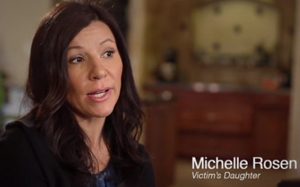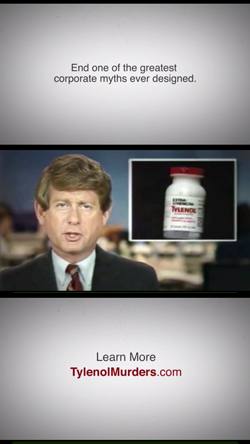Michelle Rosen, who watched her mother die of a poisoned Tylenol pill in 1982 after returning from the hospital after giving birth, is seeking to reopen investigation of the murders. She challenges the "madman going from store-to-store" theory.
 Rosen and others have created a 4:32-minute video charging that the Tylenol capsules were poisoned in one of the many links in the distribution chain of Johnson & Johnson, which continues to be lauded for its PR response to the crisis. The clip is part of a Kickstarter campaign to fund a documentary about the murders.
Rosen and others have created a 4:32-minute video charging that the Tylenol capsules were poisoned in one of the many links in the distribution chain of Johnson & Johnson, which continues to be lauded for its PR response to the crisis. The clip is part of a Kickstarter campaign to fund a documentary about the murders.
Rosen contends there is no evidence to support the "madman" theory and plenty that points to the J&J distribution process that sent Tylenol ingredients through as many as five different sets of hands on the way to store shelves. That process was described in the 499-page book The Tylenol Mafia, by Scott Bartz, a J&J employee from 2000-07.
Some Tylenol was shipped in bulk in fiber drums (powder or capsules) to repackagers who bottled it and packaged it. Cartons containing 72 Tylenol bottles were shipped to distribution centers where they were opened by warehouse workers who put individual bottles into "picking" machines where they were filled.
The bottles were handled again by the picking machine operators who filled orders for individual stores. Another handling was by workers who boxed the items for the individual stores. Rack jobbers/merchandisers then restocked the shelves, yet another handling.
None of the press coverage either in 1982 or thereafter ever discussed this serpentine route of acetaminophen to store shelves. J&J did not have a press conference after the initial murders because there would have been many questions on how the company delivers Tylenols to stores. Reporters were handled individually.
Other evidence implicating J&J is that 27-year-old Lynn Reiner, Rosen’s mother, who had just given birth, got her Tylenols from the hospital dispensary. No one was able to breach that security.
The Rosen video notes that “evidence” in the form of millions of Tylenol bottles was turned over to J&J, a possible suspect, and that most of the bottles and their contents were destroyed.
This stands normal police work on its head. Also, large quantities of pills and bottles were thrown away or flushed down the toilet on advice of police and others who went through Chicago suburbs with bullhorns advising such action.
Rosen seeks to raise $75,000 so that efforts to unseal documents in the case can go forward and a full-length documentary can be made.
Media Doze
 Media, including the New York Times, Washington Post, The Economist, Fortune and the Christian Science Monitor, have looked and continue to look at the tragic event from the wrong end of the telescope -- missing the "elephant in the room."
Media, including the New York Times, Washington Post, The Economist, Fortune and the Christian Science Monitor, have looked and continue to look at the tragic event from the wrong end of the telescope -- missing the "elephant in the room."
The right end would be examining the death of 23-year-old Diane Elsroth of Peekskill on Feb. 17, 1986 from a Tylenol capsule laced with cyanide. No over-the-counter drug should ever have been sold in easily taken apart and spiked capsules and especially not after seven people died that way.
The introduction of "tamper-resistant" packaging on Nov. 11, 1982, less than six weeks after the murders, ignored the possibility that someone could open a package, doctor the capsules, and put them back in the medicine cabinet. Someone in a bar could hand a spiked capsule to a victim.
J&J, rushing back to the market with the flawed capsules (when tamper-proof tablets dissolve just as quickly in the stomach), was concerned with market share. The company, fearing someone might misuse the capsules, was ready with tamper-resistant packaging. It ran commercials as early as Oct. 24, 1982 to promote it.
CEO James Burke, facing a conference at the National Press Club Feb. 19, 1986, two days after the death of Elsroth, said, "Yes, indeed, I am," when asked whether he was sorry J&J continued to sell Tylenols in capsules.
Major media have refused to re-visit the 1982-86 murders. PRSA in 1983 gave J&J a special Silver Anvil in the crisis category after it had lost to Hygrade Hot Dogs, which had a contamination crisis.
J&J disqualified itself from a regular Anvil by refusing to provide a budget for handling the Tylenol murders.
A special discussion of the Tylenol murders on Wikibooks fails to mention the murder of Elsroth. It is also not mentioned in the main Tylenol murders entry.
WP says J&J “seemed to show a perfect example of how businesses should professionally and ethically react to crises. They placed human lives above profit and focused on longterm sustainability. J&J quickly recalled Tylenol bottles and notified the public sufficiently to prevent further poisonings. Seeming not to be influenced by cost benefit analysis, J&J made the largest recall ever in the drug industry.”
Media Swallow J&J Pill
A nearly three-age feature in the Aug. 22, 2010 Sunday NYT praised J&J’s handling of the 1982 murders as “Exhibit A in the lesson book on forthright crisis management.” The front page business section article was by Peter Goodman.
NYT reporter Natasha Singer on May 3, 2010 wrote that “J&J is considered a model for the consumer products industry for its fast and adept handling of a Tylenol scare in 1982 when seven people in Chicago died after taking capsules that had been laced with cyanide.”
The Economist said in April 2010 that J&J/Tylenol is the “gold standard in crisis management.” The comment was in a column called “Schumpeter” written by Adrian Woolridge.
The Christian Science Monitor said Jan. 15, 2010 that what J&J did in 1982 “is still regarded as a shining example of corporate social responsibility.”
The Motley Fool said on May 6, 2011 that what J&J did “has always been the poster child for how to handle a crisis.”
Fortune magazine on May 28, 2007, hailed J&J/Tylenol in a full page article as the “gold standard in crisis control.” The writer was Jia Lynn Yant.
James Lukaszewski, a member of the Ethics Board of PRSA and referred to as an expert in crises, told this website in 2012 that “The 1982 Tylenol incident remains the most internationally recognized successful crisis incident response, even after all these years.”
The March 2008 Tactics monthly of the PR Society praised J&J/Tylenol as “an enduring example of crisis management done right.” It quoted J&J VP-PR Lawrence Foster as saying, “Every PR decision was based on sound, socially responsible principles.”
Foster told Tactics that J&J was “completely open with the media” although no press conference was held. Telephone calls were handled privately with individual reporters. There was a teleconference on Nov. 11 when J&J introduced the new packaging. Questions were allowed then.


 There’s a fine line between newsjacking and taking advantage, aka ambulance chasing. Our job as PR professionals is to tread it carefully.
There’s a fine line between newsjacking and taking advantage, aka ambulance chasing. Our job as PR professionals is to tread it carefully. PR firms need to be mindful of ways their work product may be protected by the attorney-client privilege whenever working with a client’s internal legal team or its external legal counsel.
PR firms need to be mindful of ways their work product may be protected by the attorney-client privilege whenever working with a client’s internal legal team or its external legal counsel. Manuel Rocha, former US ambassador and intenational business advisor to LLYC, plans to plead guilty to charges that he was a secret agent for Cuba.
Manuel Rocha, former US ambassador and intenational business advisor to LLYC, plans to plead guilty to charges that he was a secret agent for Cuba. CEO mentoring is an often-overlooked aspect of why CEOs are able to make good decisions, and sometimes make bad ones—all of which intersects with the role and duties of a board.
CEO mentoring is an often-overlooked aspect of why CEOs are able to make good decisions, and sometimes make bad ones—all of which intersects with the role and duties of a board.  How organizations can anticipate, prepare and respond to crises in an increasingly complex world where a convergent landscape of global challenges, threats and risks seem to arrive at an unrelenting pace.
How organizations can anticipate, prepare and respond to crises in an increasingly complex world where a convergent landscape of global challenges, threats and risks seem to arrive at an unrelenting pace.


 Have a comment? Send it to
Have a comment? Send it to 
No comments have been submitted for this story yet.